NCERT Solutions for Class 11 Chemistry Chapter 11 The p-Block Elements
Topics and Subtopics in NCERT Solutions for Class 11 Chemistry Chapter 11 The p-Block Elements:
| Section Name | Topic Name |
| 11 | The p-Block Elements |
| 11.1 | Group 13 Elements: The Boron Family |
| 11.2 | Important Trends and Anomalous Properties of Boron |
| 11.3 | Some Important Compounds of Boron |
| 11.4 | Uses of Boron and Aluminium and their Compounds |
| 11.5 | Group 14 Elements: The Carbon Family |
| 11.6 | Important Trends and Anomalous Behaviour of Carbon |
| 11.7 | Allotropes of Carbon |
| 11.8 | Some Important Compounds of Carbon and Silicon |
NCERT Class 11 Chemistry Textbook Solved Questions
Question 1. Discuss the pattern of variation in the oxidation states of
(i) B to Tl (ii) C to Pb.
Answer: (i) B to Tl
Common oxidation states are +1 and +3. The stability of +3 oxidation state decreases from B to Tl. +1 oxidation state increases from B to Tl.
(ii) C to Pb
The common oxidation states are +4 and +2. Stability of +4 oxidation state decreases from C to Pb.
Details can be seen from the text part.
Question 2. How can you explain higher stability of BCl3 as compared to TlCl3?
Answer: BCl3 is quite stable. Because there is absence of d- and f-electrons in boron three valence electrons (2s2 2px1) are there for bonding with chlorine atom. In Tl the valence s-electron (6s2) are experiencing maximum inert pair effect. Thus, only 6p1 electron is available for bonding. Therefore, BCl3 is stable but TlCl3 is comparatively unstable.
Question 3. Why does borontrifluori.de behave as a Lewis acid?
Answer: In BF3, central atom has only six electrons after sharing with the electrons of the F
atoms. It is an electron-deficient compound and thus behaves as a Lewis acid.
Question 4. Consider the compounds, BCl3, and CCl4. How will they’behave with water justify?
Answer: In BCl3, there is only six electrons in the valence shell of B atom. Thus, the octet is incomplete and it can accept a pair of electrons from water and hence BCl3 undergoes hydrolysis. Whereas, in CCl4, C atom has 8 electrons and its octet is complete. That’s why it has no tendency to react with water.
CCl4 + H20 —————> No reaction
Question 5. Is boric acid a protonic acid? Explain.
Answer: Boric acid is a Lewis acid, it is not a protonic acid.
Boric acid accepts electrons from hydroxyl ion of H2O molecule.
B (OH)3 + 2HOH ————> [B (OH)4]– + H3O+
Question 6. Explain what happens when boric acid is heated.
Answer: On heating boric acid above 370 K, it forms metaboric acid, HB02 which on further heating yields boric oxide B2O3.![]()
Question 7. Describe the shapes of BF3 and BH4–. Assign the hybridisation of boron in these species.
Answer: In BF3, boron is SP2 hybridized.
∴ shape of BF3 = planar.
In [BH4]–, boron is sp3 hybridized, thus the shape is tetrahedral.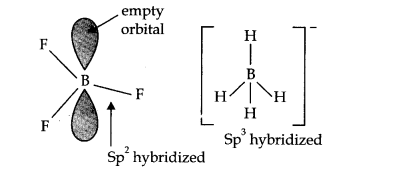
Question 8. Write reactions to justify amphoteric nature of aluminium.
Answer: Aluminium reacts with acid as well as base. This shows amphoteric nature of aluminium.
2Al(s) + 6HCl(dil.) ——> 2AlCl3(aq) + 3H2(g)
2Al(s) + 2NaOH(aq) + 6H2O(l) ———-> 2Na+ [Al(OH)4]–(aq) + 3H2(g)
Question 9. What are electron deficient compounds? Are BCl3 and SiCl4 electron deficient species? Explain.
Answer: Electron deficient species are those in which the central atom in their molecule has the tendency to accept one or more electron pairs. They are also known as Lewis acid. BCl3 and SiCl4 both are electron deficient species.
Since, in BCl3, B atom has only six electrons. Therefore, it is an electron deficient compound.
In SiCl4 the central atom has 8 electrons but it can expand its covalency beyond 4 due to the presence of d-orbitals.
Thus, SiCl4 should also be considered as electron-deficient species.
Question 10. Write the resonance structure of CO32- and HCO3– .
Answer: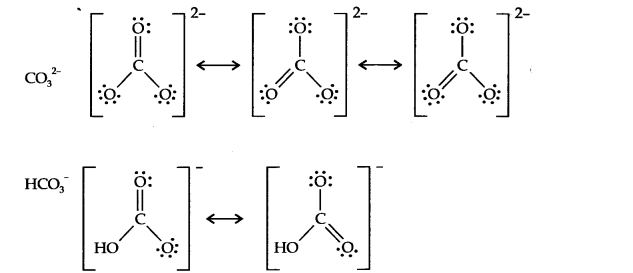
Question 11. What is the state of hybridisation of carbon in
(a) CO32- (b) diamond (c) graphite?
Answer: (a) CO32- (sp2) (b) Diamond (sp3) (c) Graphite (sp2)
Question 12. Explain the difference in properties of diamond and graphite on the basis of their structures.
Answer:
- Since diamond exists as a three dimensional network solid, it is the hardest substance known with high density and high melting point.
Whereas in graphite, any two successive layers are held together by weak forces of attraction. This makes graphite soft. - In graphite, carbon atom is sp2 hybridized whereas in diamond, carbon atom is sp3 hybridized.
- Unlike diamond, graphite is good conductor of heat and electricity.
Question 13.
- Rationalise the given statements and give chemical reactions:
- Lead (II) chloride reacts with Cl2 to give PbCl4 .
- Lead (IV) chloride is highly unstable towards heat.
- Lead is known not to form an iodide Pbl4.
Answer:
- PbCl2 + Cl2 ———> PbCl4.
This is because Pb can show +2 oxidation state more easily than +4 due to inert pair effect.
heat - PbCl4 ———> PbCl2 + Cl2
Because Pb2+ is more stable than Pb4+ due to inert pair effect. - Pbl4 does not exist because I- ion being a powerful reducing agent reduces Pb4+ ion to Pb2+ ion in solution.
- Pb4+ + 2I– ——-> Pb2+ + l2
Pb(IV) Pb(II)
Question 14. Suggest reason why the B-F bond lengths in BF3 (130 pm) and BF– (143 pm) differ.
Answer: In BF3 ‘B’ is sp2 hybridised and in BF4– ‘B’ is sp3 hybridised. Thus, the difference in bond length is due to the state of hybridisation.
Question 15. If B-Cl bond has a dipole moment, explain why BCl3 molecule has zero dipole moment.
Answer: B-Cl bond has dipole moment because of polarity. In BCl3 since the molecule is symmetrical (planar). Thus the polarities cancel out.
Question 16. Aluminium trifluoride is insoluble in anhydrous HF but dissolves on addition of NaF. Aluminium trifluoride precipitates out of the resulting solution when gaseous BF3 is bubbled through. Give reason.
Answer: Since, anhydrous HF is covalent compound and weak acid due to high bond dissociation energy. AlF3 does not dissolve in HF.
Whereas NaF is ionic compound.
3NaF + AlF3 ———> Na3[AlF6]
Na3[AlF6] + 3BF3(g) ——-> AlF3 + 3Na+ [BF]–
Question 17. Suggest a reason as to why CO is poisonous.
Answer: CO reacts with haemoglobin to form carboxyhaemoglobin which can destroy the oxygen carrying capacity of haemoglobin and the man dies of suffocation.
Question 18. How is excessive content of C02 responsible for global warming?
Answer: Excess of C02 absorbs heat radiated by the earth. Some of it is dissipated into the atmosphere while the remaining part is radiated back to the earth. As a result, temperature of the earth increases. This is the cause of global warming.
Question 19. Explain structures of diborane and boric acid.
Answer: Boric acid contains planar BO33- ions which are linked together through hydrogen bonding shown in the fig.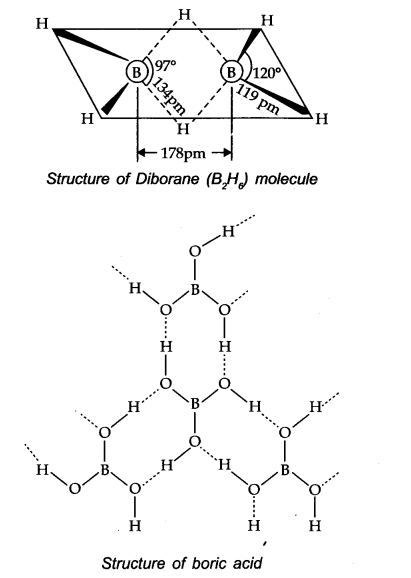
Question 20. What happens when
(a) Borax is heated strongly
(b) Boric acid is added to water
(c) Aluminium is treated with dilute NaOH
(d) BF3 is reacted with ammonia?
Answer:
Question 21. Explain the following reactions.
(a) Silicon is heated with methyl chloride at high temperature in the presence of copper.
(b) Silicon dioxide is treated with hydrogen fluoride.
(c) CO is heated with ZnO.
(d) Hydrated alumina is treated with aqueous NaOH solution.
Answer: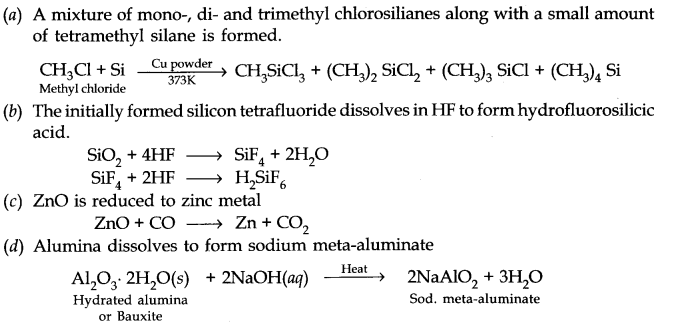
Question 22. Give reasons:
(i) Cone. HNO3 can be transported in aluminium container.
(ii) A mixture of dilute NaOH and aluminium pieces is used to open drain.
(iii) Graphite is used as lubricant.
(iv) Diamond is used as an abrasive.
(v) Aluminium alloys are used to make aircraft body.
(vi) Aluminium utensils should not be kept in water overnight.
(vii) Aluminium wire is used to make transmission cables.
Answer: (i) Al reacts with cone. HNO3 to form a very thin film of aluminium oxide on its surface which protects it from further reaction.
2Al(s) + 6HNO3(conc.) ———> Al2O3(s) + 6NO2(g) + 3H2O(l)
(ii) NaOH reacts with Al to evolve H2 gas. Thus the pressure of the gas produced can be used for clogged drains.
2Al(s) + 2NaOH(aq) + 2H2O(l) ——-> 2NaAlO2(aq) + 3H2(g)
(iii) Graphite has layered structure which are held by weak van der Waals forces. Thus, graphite cleaves easily between the layers, therefore it is very soft and slippery. That’s why it is used as lubricant.
(iv) Diamond is used as an-abrasive because it is an extremely hard substance.
(v) Alloys of aluminium, like duralumin, is used to make aircraft body due to some of its property like toughness, lightness and resistant to corrosion.
(vi) Generally, aluminium metal does not react with water quickly but, when it is kept overnight, it reacts slowly with water in presence of air.
2Al(s) + O2(g) + H2O(l) ——–> Al2O3(S) + H2(g)
a very small amount of (in ppm) Al3+ produced in the solution is injurious to health if the water is used for drinking purposes.
(vii) Aluminium is generally unaffected by air and moisture and it is also good conductor of electricity. That’s why it is used in transmission cables.
Question 23. Explain why is there a phenomenal decrease in ionization enthalpy from carbon to silicon.
Answer: Because there is increase in atomic size on moving from carbon to silicon, the screening effect increases. Thus the force of attraction of nucleus for the valence electron decreases as compared to carbon. Thus the ionization enthapy decreases from carbon to silicon.
Question 24. How would you explain the lower atomic radius of Ga as compared to Al?
Answer: Due to poor shielding effect of d-electrons in Ga, the electrons in gallium experience great force of attraction by nucleus as compared to Al.
Question 25. What are allotropes? Sketch the structure of two allotropes of carbon namely diamond and graphite. What is the impact of structure on physical properties of two allotropes?
Answer: Allotropes: Allotropes are the different forms of an element which are having same chemical properties but different physical properties due to their structures.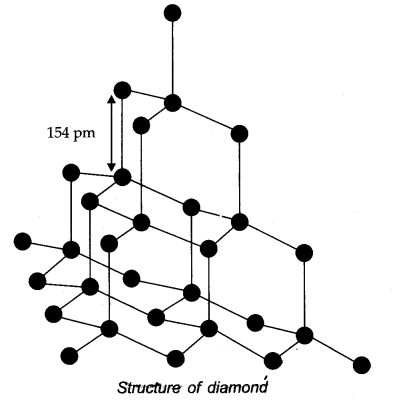
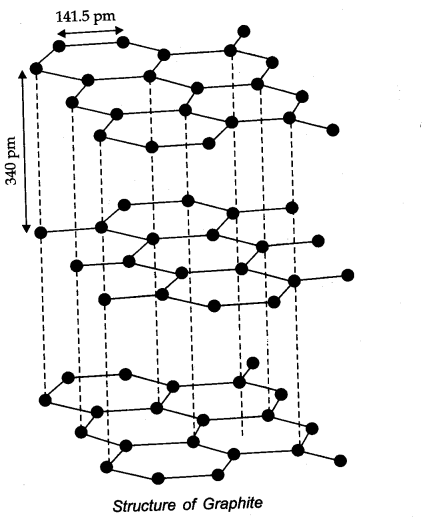
In diamond, carbon is SP3 -hybridized. Since, diamond is three dimensional network solid, it is hardest substance with high density whereas graphite has a layered structure. The various layers are formed by van der Waals forces of attraction that’s why graphite is soft and slippery.
Question 26. (a) Classify the following oxides as neutral, acidic, basic or amphoteric
CO, B2O2, Si02, C02, Al2O3, PbO2, Tl2O3
(b) Write suitable equations to show their nature.
Answer: (a) Neutral — CO
Acidic — B2O2, Si02, C02 Basic — Tl2O3 Amphoteric — Tl2O3, PbO2
(b)-CO does not react with acid as well as base at room temperature.
Being acidic B2O3, Si02 and C02 reacts with alkalis to form salts.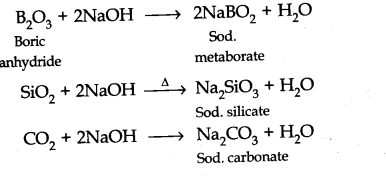
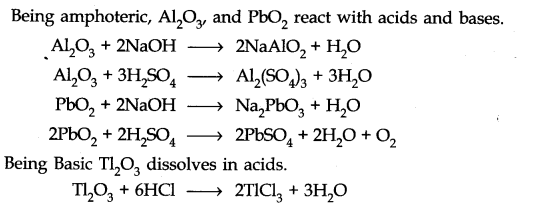
Question 27. In some of the reactions thallium resembles aluminium, whereas in others it resembles with group 1 metals. Support this statement by giving some evidences.
Answer: Tl shows both the oxidation state +1 and +3 due to inert pair effect. Tl forms basic oxide like group I elements. TlO2 is strongly basic.
Question 28. When metal X is treated with sodium hydroxide, a white precipitate (A) is obtained, which is soluble in excess of NaOH to give soluble complex (B). Compound (A) is soluble in dilute HCl to form compound (C). The compound (A) when heated strongly gives (D), which is used to extract metal. Identify (X), (A), (B), (C) and (D). Write suitable equations to support their identities.
Answer:
Question 29. What do you understand by (a) inert pair effect (b) allotropy and (c) catenation?
Answer: (a) Inert pair effect: The pair of electron in the valence shell does not take part in bond formation is called inert pair effect.
(b)Allotropy: It is the property of the element by which an element can exist in two or more forms which have same chemical properties but different physical properties due to their structures.
(c)Catenation: The property to form chains or rings not only with single bonds but also with multiple bonds with itself is called catenation.
For example, carbon forms chains with (C-C) single bonds and also with multiple bonds (C = C or C = C).
Question 30. A certain salt X, gives the following results.
(i) Its aqueous solution is alkaline to litmus.
(ii) It swells up to a glassy material Y on strong heating.
(iii) When cone.H2SO4is added to a hot solution of X, white crystal of an acid Z separates out.
Answer:![]()

Question 31. Write balanced equations for:
Answer: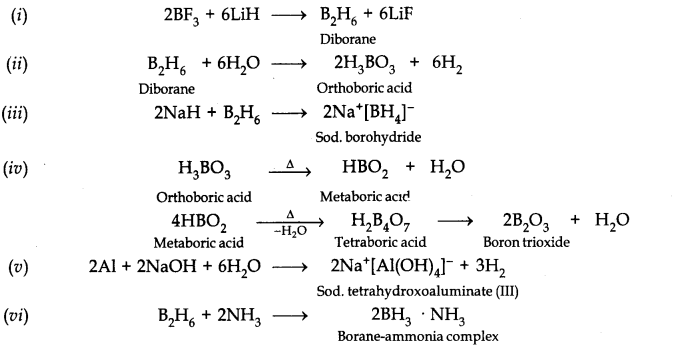
Question 32. Give one method for industrial preparation and one for laboratory preparation of CO and C02 each.
Answer: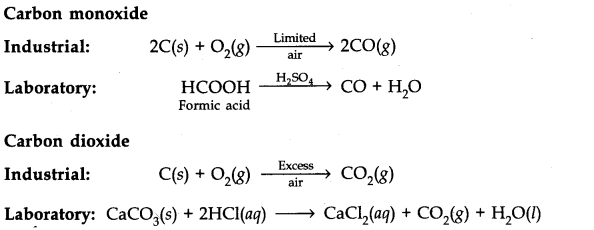
Question 33. An aqueous solution of borax is
(a) neutral (b) amphoteric (c) basic (d) acidic
Answer: Borax is a salt of a strong base (NaOH) and a weak acid (H3BO3), therefore, it is basic in nature, i.e., option (c) is correct.
Question 34. Boric acid is polymeric due to
(a) its acidic nature (b) the presence of hydrogen bonds
(c) its monobasic nature (d) its geometry
Answer: Boric acid is polymeric due to the presence of H-bonds. Therefore, option (b) is correct.
Question 35. The type of hybridisation of boron in diborane is
(a) sp (b) sp2(c) sp3(d) dsp2
Answer: In B2H6, B is sp3-hybridized. Therefore, option (c) is correct.
Question 36. Thermodynamically the most stable form of carbon is
(a)diamond (b) graphite (c) fullerenes (d) coal
Answer: Thermodynamically the most stable form of carbon is graphite, i.e., option (b) is correct.
Question 37. Elements of group 14
(a) exhibit oxidation state of +4 only (b) exhibit oxidation state of +2 and +4
(c) form M2-and M4+ ion (d) form M2+ and M4+ ions.
Answer: Due to inert pair effect, elements of group 14 exhibit oxidation states of +2 and +4. Thus, option (b) is correct.
Question 38. If the starting material for the manufacture of silicons is RSiCl3 write the structure of the product formed.
Answer: Hydrolysis of aikyltrichlorosilanes gives cross-linked silicons.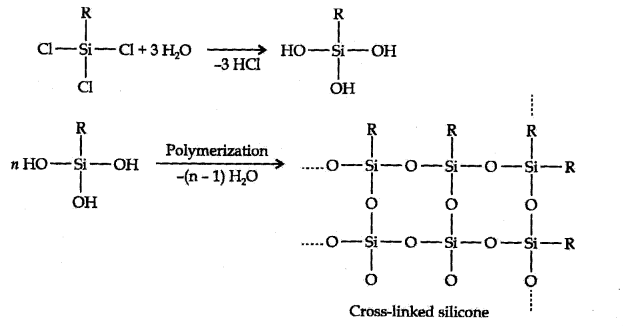
Post a Comment